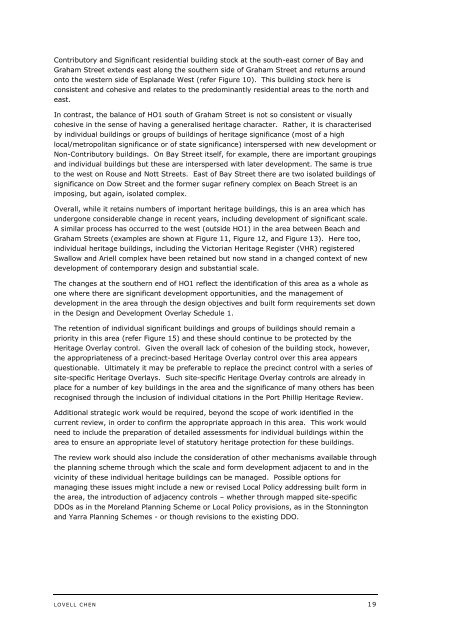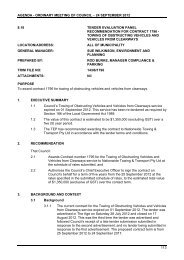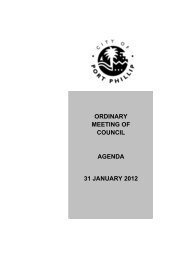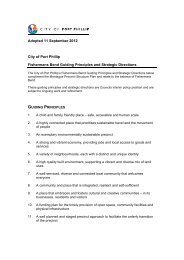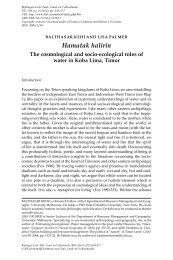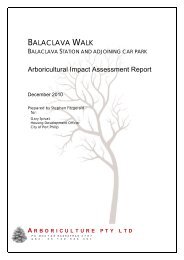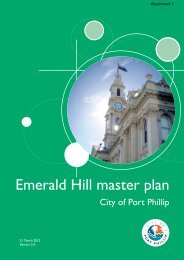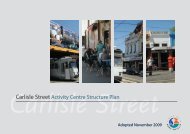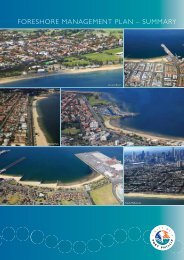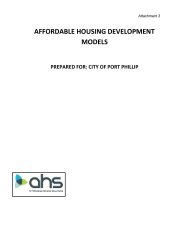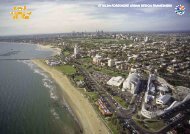Review of Heritage Overlay 1 Port Melbourne ... - City of Port Phillip
Review of Heritage Overlay 1 Port Melbourne ... - City of Port Phillip
Review of Heritage Overlay 1 Port Melbourne ... - City of Port Phillip
You also want an ePaper? Increase the reach of your titles
YUMPU automatically turns print PDFs into web optimized ePapers that Google loves.
Contributory and Significant residential building stock at the south-east corner <strong>of</strong> Bay and<br />
Graham Street extends east along the southern side <strong>of</strong> Graham Street and returns around<br />
onto the western side <strong>of</strong> Esplanade West (refer Figure 10). This building stock here is<br />
consistent and cohesive and relates to the predominantly residential areas to the north and<br />
east.<br />
In contrast, the balance <strong>of</strong> HO1 south <strong>of</strong> Graham Street is not so consistent or visually<br />
cohesive in the sense <strong>of</strong> having a generalised heritage character. Rather, it is characterised<br />
by individual buildings or groups <strong>of</strong> buildings <strong>of</strong> heritage significance (most <strong>of</strong> a high<br />
local/metropolitan significance or <strong>of</strong> state significance) interspersed with new development or<br />
Non-Contributory buildings. On Bay Street itself, for example, there are important groupings<br />
and individual buildings but these are interspersed with later development. The same is true<br />
to the west on Rouse and Nott Streets. East <strong>of</strong> Bay Street there are two isolated buildings <strong>of</strong><br />
significance on Dow Street and the former sugar refinery complex on Beach Street is an<br />
imposing, but again, isolated complex.<br />
Overall, while it retains numbers <strong>of</strong> important heritage buildings, this is an area which has<br />
undergone considerable change in recent years, including development <strong>of</strong> significant scale.<br />
A similar process has occurred to the west (outside HO1) in the area between Beach and<br />
Graham Streets (examples are shown at Figure 11, Figure 12, and Figure 13). Here too,<br />
individual heritage buildings, including the Victorian <strong>Heritage</strong> Register (VHR) registered<br />
Swallow and Ariell complex have been retained but now stand in a changed context <strong>of</strong> new<br />
development <strong>of</strong> contemporary design and substantial scale.<br />
The changes at the southern end <strong>of</strong> HO1 reflect the identification <strong>of</strong> this area as a whole as<br />
one where there are significant development opportunities, and the management <strong>of</strong><br />
development in the area through the design objectives and built form requirements set down<br />
in the Design and Development <strong>Overlay</strong> Schedule 1.<br />
The retention <strong>of</strong> individual significant buildings and groups <strong>of</strong> buildings should remain a<br />
priority in this area (refer Figure 15) and these should continue to be protected by the<br />
<strong>Heritage</strong> <strong>Overlay</strong> control. Given the overall lack <strong>of</strong> cohesion <strong>of</strong> the building stock, however,<br />
the appropriateness <strong>of</strong> a precinct-based <strong>Heritage</strong> <strong>Overlay</strong> control over this area appears<br />
questionable. Ultimately it may be preferable to replace the precinct control with a series <strong>of</strong><br />
site-specific <strong>Heritage</strong> <strong>Overlay</strong>s. Such site-specific <strong>Heritage</strong> <strong>Overlay</strong> controls are already in<br />
place for a number <strong>of</strong> key buildings in the area and the significance <strong>of</strong> many others has been<br />
recognised through the inclusion <strong>of</strong> individual citations in the <strong>Port</strong> <strong>Phillip</strong> <strong>Heritage</strong> <strong>Review</strong>.<br />
Additional strategic work would be required, beyond the scope <strong>of</strong> work identified in the<br />
current review, in order to confirm the appropriate approach in this area. This work would<br />
need to include the preparation <strong>of</strong> detailed assessments for individual buildings within the<br />
area to ensure an appropriate level <strong>of</strong> statutory heritage protection for these buildings.<br />
The review work should also include the consideration <strong>of</strong> other mechanisms available through<br />
the planning scheme through which the scale and form development adjacent to and in the<br />
vicinity <strong>of</strong> these individual heritage buildings can be managed. Possible options for<br />
managing these issues might include a new or revised Local Policy addressing built form in<br />
the area, the introduction <strong>of</strong> adjacency controls – whether through mapped site-specific<br />
DDOs as in the Moreland Planning Scheme or Local Policy provisions, as in the Stonnington<br />
and Yarra Planning Schemes - or though revisions to the existing DDO.<br />
L O V E L L C H E N 19


